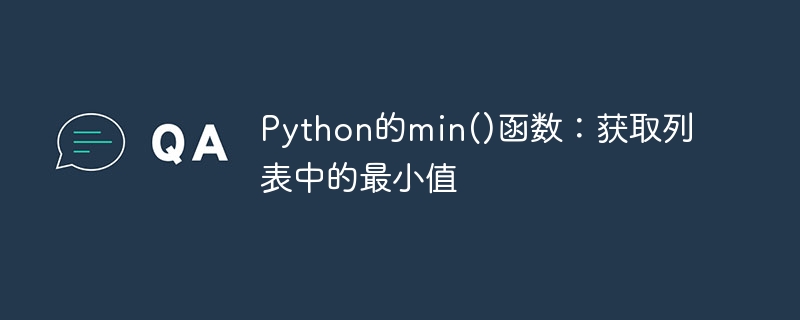

Python's min() function: Get the minimum value in the list, specific code examples are required
The Python programming language is a simple, easy-to-learn and powerful language. It provides many built-in functions to handle lists and other data structures. One of the very useful built-in functions is the min() function, which can be used to get the minimum value in a list.
In Python, we often need to find the smallest element in a list. This task can be accomplished by looping through the list and recording the minimum value, but this approach is tedious and error-prone. The min() function can accomplish this task in a more concise way.
The syntax of the min() function is very simple. It accepts an iterable object as a parameter and returns the minimum value in the object. Here is an example:
numbers = [5, 2, 9, 1, 7] min_number = min(numbers) print(min_number) # 输出结果为1
In the above example, we defined a list of numbers containing 5 integers. We then use the min() function to get the minimum value in the list and assign the result to the variable min_number. Finally, we print the minimum value using the print() function.
In addition to lists, the min() function can also be used for other types of iterable objects, such as tuples and sets. Here is an example of using tuples:
animals = ('cat', 'dog', 'elephant', 'lion') min_animal = min(animals) print(min_animal) # 输出结果为cat
In the above example, we define a tuple animals containing four strings. We then use the min() function to get the minimum value in the tuple and assign the result to the variable min_animal. Finally, we print the minimum value using the print() function.
In addition to the default comparison method, the min() function can also accept an optional key parameter to specify the method of comparing elements. For example, if we want to get the shortest string in a list of strings based on the length of letters, we can use the len() function as the key parameter. Here is an example:
words = ['apple', 'banana', 'orange', 'kiwi'] min_word = min(words, key=len) print(min_word) # 输出结果为kiwi
In the above example, we define a list of four strings words. We then use the min() function to get the shortest string in the list and assign the result to the variable min_word. Finally, we print the shortest string using the print() function.
To summarize, the min() function is a very useful function in Python and can be used to obtain the minimum value in lists and other iterable objects. Its use is very simple, just pass the object to be compared as a parameter to the function. In addition, you can specify the comparison method through the optional key parameter. In actual programming, the min() function is often used to find the minimum value, as well as in some sorting and search algorithms. I hope the above code examples can help you better understand and use the min() function.
The above is the detailed content of Python's min() function: Get the minimum value in a list. For more information, please follow other related articles on the PHP Chinese website!




